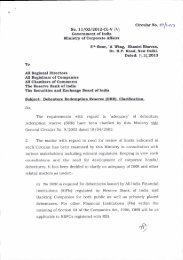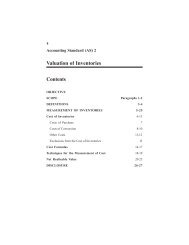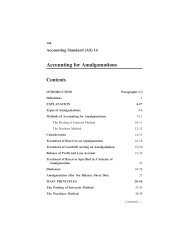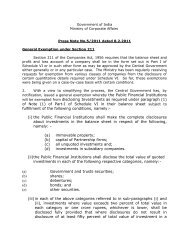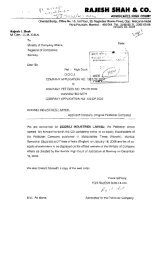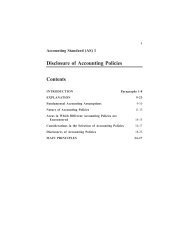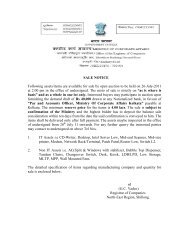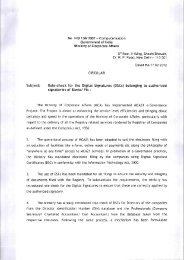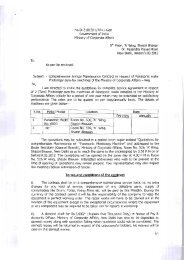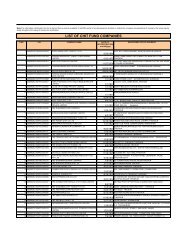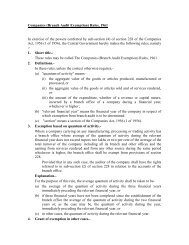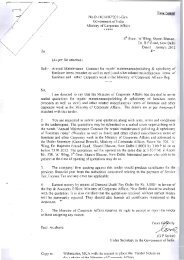Indian Accounting Standards(Ind AS) 1
Indian Accounting Standards(Ind AS) 1
Indian Accounting Standards(Ind AS) 1
You also want an ePaper? Increase the reach of your titles
YUMPU automatically turns print PDFs into web optimized ePapers that Google loves.
91 An entity may present components of other comprehensive income either:<br />
(a) net of related tax effects, or<br />
(b) before related tax effects with one amount shown for the aggregate amount<br />
of income tax relating to those components.<br />
92 An entity shall disclose reclassification adjustments relating to<br />
components of other comprehensive income.<br />
93 Other <strong>Ind</strong> <strong>AS</strong>s specify whether and when amounts previously recognised in<br />
other comprehensive income are reclassified to profit or loss. Such<br />
reclassifications are referred to in this Standard as reclassification adjustments.<br />
A reclassification adjustment is included with the related component of other<br />
comprehensive income in the period that the adjustment is reclassified to profit<br />
or loss. For example, gains realised on the disposal of available-for-sale<br />
financial assets are included in profit or loss of the current period. These<br />
amounts may have been recognised in other comprehensive income as<br />
unrealised gains in the current or previous periods. Those unrealised gains<br />
must be deducted from other comprehensive income in the period in which the<br />
realised gains are reclassified to profit or loss to avoid including them in total<br />
comprehensive income twice.<br />
94 An entity may present reclassification adjustments in the statement of profit and<br />
loss or in the notes. An entity presenting reclassification adjustments in the<br />
notes presents the components of other comprehensive income after any<br />
related reclassification adjustments.<br />
95 Reclassification adjustments arise, for example, on disposal of a foreign<br />
operation (see <strong>Ind</strong> <strong>AS</strong> 21), on derecognition of available-for-sale financial<br />
assets (see <strong>Ind</strong> <strong>AS</strong> 39) and when a hedged forecast transaction affects profit or<br />
loss (see paragraph 100 of <strong>Ind</strong> <strong>AS</strong> 39 in relation to cash flow hedges).<br />
96 Reclassification adjustments do not arise on changes in revaluation surplus<br />
recognised in accordance with <strong>Ind</strong> <strong>AS</strong> 16 or <strong>Ind</strong> <strong>AS</strong> 38 or on actuarial gains and<br />
losses on defined benefit plans recognised in accordance with paragraphs 92<br />
and 129A of <strong>Ind</strong> <strong>AS</strong> 19. These components are recognised in other<br />
comprehensive income and are not reclassified to profit or loss in subsequent<br />
periods. Changes in revaluation surplus may be transferred to retained earnings<br />
in subsequent periods as the asset is used or when it is derecognised (see <strong>Ind</strong><br />
<strong>AS</strong> 16 and <strong>Ind</strong> <strong>AS</strong> 38). Actuarial gains and losses are reported in retained<br />
earnings in the period that they are recognised as other comprehensive income<br />
(see <strong>Ind</strong> <strong>AS</strong> 19).<br />
Information to be presented in the statement of profit and loss or in<br />
the notes<br />
97 When items of income or expense are material, an entity shall disclose<br />
their nature and amount separately.<br />
98 Circumstances that would give rise to the separate disclosure of items of<br />
income and expense include:<br />
(a) write-downs of inventories to net realisable value or of property, plant and<br />
equipment to recoverable amount, as well as reversals of such writedowns;<br />
21



